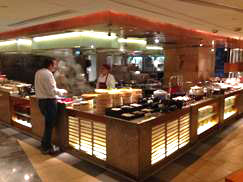Consultant Juan Martinez explores the intricacies associated with balancing hospitality and unit economics when it comes to restaurant development and design.
 At the Shangri-La Hotel in Hong Kong, food preparation is on full display for customers.Earlier this summer I had the opportunity to combine business and pleasure during a trip to Asia. I saw a number of interesting restaurant concepts while vacationing and doing a little bit of work. One common attribute many of the concepts shared is an open kitchen that allows the customers to see much of the cooking and production areas. They still had a prep side that customers could not see.
At the Shangri-La Hotel in Hong Kong, food preparation is on full display for customers.Earlier this summer I had the opportunity to combine business and pleasure during a trip to Asia. I saw a number of interesting restaurant concepts while vacationing and doing a little bit of work. One common attribute many of the concepts shared is an open kitchen that allows the customers to see much of the cooking and production areas. They still had a prep side that customers could not see.
Another typical vacation activity is to catch up on reading. So, while preparing to write my next blog post, I got inspiration not only from seeing so many unique and innovative concepts but also from reading the latest edition of restaurant development + design, FE&S’ sister publication. I read this edition from end to end and if you don’t already subscribe to rd+d, you should consider doing so today. It provides great industry insights on restaurant design and optimization.
In the July/August issue, I began to reflect on the reality that the restaurant industry always seems to be a hub of activity, almost regardless of the economic climate. And I was left feeling that for some reason the restaurant industry has been even more active than normal during the last year or so.
New concepts keep coming online (see: fast-casual pizza’s boom), and financial institutions and private equity firms seem to be more active than ever in the restaurant industry (See: Roark Capital’s investment in NAF NAF Grill). And this comes not long after concepts such as Shake Shack and Wing Stop launched their initial public offerings. Additionally, international concepts like Nando’s continue to expand their presence in the U.S., including a very successful opening in Chicago. Indeed, there’s no shortage of activity in the restaurant industry.
While it’s interesting to watch all of these developments unfold, we can’t confuse activity with success. The bigger challenge for concepts like the ones previously mentioned is devising a recipe for their secret sauce … that proper mix of the menu, marketing and operational ingredients that work together to drive the right unit economics. I am convinced the concepts that sustain growth are those who take an analytical approach to designing and managing their restaurants. Ultimately, this approach should drive the right return-on-investment.
Further, in an era dominated by too many “me too” competitors, every restaurant concept must be able to clearly articulate and illustrate its differentiating proposition. Rest assured if one concept emerges successfully, dozens of others will imitate it almost immediately. Want proof? Look no further than the better burger and the once again burgeoning frozen yogurt segments. If imitation is the sincerest form of flattery, there’s lots of flattery to go around in those segments.
Part of having the right unit economics is making sure that the cost of construction and development are right. The latest issue of rd+d includes an article that discusses the importance of value engineering a design. This article’s most important point: operators need to make smart investments when designing and laying out their restaurants or they run the risk of compromising the guest experience.
Over the years I have learned when designing a restaurant that it’s important to remember that “all that glitters does not have to be gold,” but if the concept needs glitter than you better add it. Just do it economically or you risk impeding the operation’s ability to achieve successful unit economics.
Some designers may still believe that “if you build it, they will come,” as the old movie adage goes. While we can argue that there is some truth to this comment, it’s equally important to be financially responsible when approaching a restaurant’s design and that includes making sure it supports the right unit economics to drive profitability. Profits cannot come at the expense of hospitality for a concept to survive long-term. The opposite rings true, too: you can’t degrade hospitality to drive profits.
Bottom-line: any design efforts should strive to achieve profitable hospitality, balancing these two areas carefully and in synergy.



